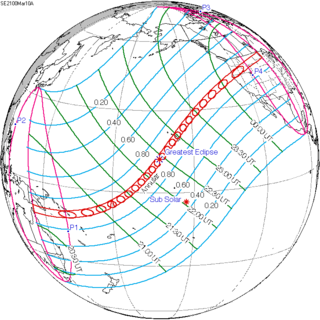| Solar eclipse of March 10, 2100 | |
|---|---|
| Type of eclipse | |
| Nature | Annular |
| Gamma | 0.3077 |
| Magnitude | 0.9338 |
| Maximum eclipse | |
| Duration | 449 s (7 min 29 s) |
| Coordinates | 12°00′N 162°24′W / 12°N 162.4°W |
| Max. width of band | 257 km (160 mi) |
| Times (UTC) | |
| Greatest eclipse | 22:28:11 |
| References | |
| Saros | 141 (28 of 70) |
| Catalog # (SE5000) | 9733 |
An annular solar eclipse will occur at the Moon's ascending node of orbit between Wednesday, March 10 and Thursday, March 11, 2100,[1] with a magnitude of 0.9338. A solar eclipse occurs when the Moon passes between Earth and the Sun, thereby totally or partly obscuring the image of the Sun for a viewer on Earth. An annular solar eclipse occurs when the Moon's apparent diameter is smaller than the Sun's, blocking most of the Sun's light and causing the Sun to look like an annulus (ring). An annular eclipse appears as a partial eclipse over a region of the Earth thousands of kilometres wide. Occurring about 2.9 days before apogee (on March 13, 2100, at 21:10 UTC), the Moon's apparent diameter will be smaller.[2]
The path of annularity will be visible from parts of northeastern Australia, Papua New Guinea, the Solomon Islands, Tuvalu, and Hawaii, California, Oregon, northwestern Nevada, Idaho, Montana, Wyoming, North Dakota, South Dakota, and Minnesota in the United States. A partial solar eclipse will also be visible for parts of Australia, Oceania, and North America.
- ^ "March 10–11, 2100 Annular Solar Eclipse". timeanddate. Retrieved 25 August 2024.
- ^ "Moon Distances for London, United Kingdom, England". timeanddate. Retrieved 25 August 2024.
